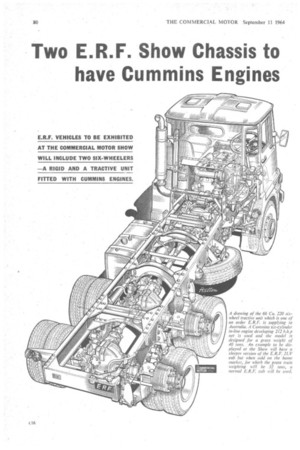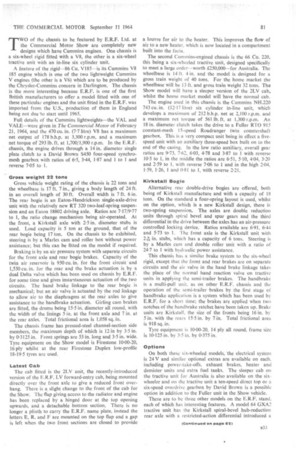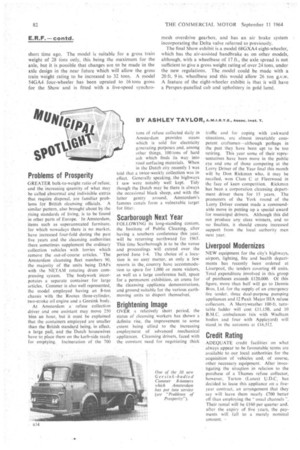Two E.R.F. Show Chassis to have Cummins Engines
Page 82

Page 83

Page 84

If you've noticed an error in this article please click here to report it so we can fix it.
TWO of the chassis to be featured by E.R.F. Ltd. at the Commercial Motor Show are completely new designs which have Cummins engines. One chassis is a six-wheel rigid fitted with a V8, the other is a six7wheel tractive unit with an in-line six cylinder unit.
A feature of the rigid---86 Cu. V185—is its Cummins V8 185 engine which is one of the two lightweight Cummins V engines (the other is a V6) which are to be produced by the Chrysler-Cummins concern in Darlington. The chassis is the more interesting because E.R.F. is one of the first British manufacturers to offer a model fitted with one of these particular engines and the unit fitted in the E.R.F. was imported from the U.S., production of them in England being not due lo start until 1965.
Full details of the Cummins lightweights—the VAL and VALE—were given in The Commercial Motor of February 21, 1964, and the 470 cu. in. (7.7 litre) V8 has a maximum net output of 178 b.h.p. at 3,300 r.p.m. and a maximum net torque of 293 lb. ft. at 1,700/1,900 r.p.m. In the E.R.F. chassis, the engine drives through a 14 in. diameter single plate clutch to a David Brown S450 four-speed synchromesh gearbox with ratios of 6-5, 3-44, 1.87 and 1 to 1 and reverse 7.05 to 1
Gross weight 22 tons Gross vehicle weight rating of the chassis is 22 tons and the wheelbase is 17 ft. 7 in., giving a body length of 24 ft. in an overall length of 30 ft. Overall width is 7 ft. 6 in. The rear bogie is an Eaton-Hendrickson single-axle-drive unit with the relatively new RT 320 two-leaf-spring suspension and an Eaton 18802 driving axle. Ratios are 7-17/9-77 to 1, the ratio change mechanism being air-operated. At the front, a Kirkstall axle with 2-5 in. diameter stubs is used. Load capacity is 5 ton at the ground, that of the rear bogie being 17 ton. On the chassis to be exhibited, steering is by a Marks cam and roller box without power assistance; but this can be fitted on the model if required.
Braking is by an air pressure system with separate circuits for the front axle and rear bogie brakes. Capacity of the twin air reservoir is 950 cu. in. for the front circuit and 1,550 cu. in. for the rear and the brake actuation is by a dual Delta valve which has been used on chassis by E.R.F. for some time and gives instantaneous actuation of the two circuits. The hand brake linkage to the rear bogie is mechanical; but an air valve is actuated by the rod linkage to allow air to the diaphragms at the rear. axles to give assistance to the handbrake actuation. Girling cam brakes are fitted, the drums being 15-5 in. diameter all round, with the width of the linings 5 in. at the front axle and 7 in. at the rear axles. Total frictional area is 1,058 sq. in.
The chassis frame has pressed-steel channel-section side members, the maximum depth of which is 12 in by 3-5 in. by 0-3125 in. Front springs are 53 in. long and 3.5 in. wide. Tyre equipment on the Show model is Firestone 10-00-20, 16 ply whilst at the rear Firestone Duplex low-profile 18-19.5 tyres are used.
Latest Cab The cab fitted is the 2LV unit, the recently-introduced version of the E.R.F. LV forward-entry cab, being mounted directly over the front axle to give a reduced front overhang. There is a slight change to the front of the cab for the Show. The flap giving access to the radiator and engine has been replaced by a hinged door at the top opening upwards, and a detachable bottom section. There is no longer a plinth to carry the E.R.F. name plate, instead the letters E, R. and F are mounted on the top flap and a gap is left when the two front sections are closed to provide a louvre for air to the heater. This improves the flow of air to a new heater, which is now located in a compartment built into the facia.
The second Cummins-engined chassis is the 66 Cu. 220, this being a six-wheeled tractive unit, designed specifically to meet a large order—worth £250,000—for Australia. The wheelbase is 14 ft. 4 in, and the model is designed for a gross train weight of 40 tons. For the home market the wheelbase will be 13 ft. and gross train weight 32 tons. The Show model will have a sleeper version of the 2LV cab, whilst the home market model will have the normal cab.
The engine used in this chassis is the Cummins NH.220 743 Cu. in. (12-17 litre) six cylinder in-line unit, which develops a maximum of 212 b.h.p. net at 2,100 r.p.m. and a maximum net torque of 561 lb. ft. at 1,300 r.p.m. An 18 in. diameter clutch takes the drive to a Fuller RTO 915 constant-mesh 15-speed Roadranger twin countershaft gearbox. This is a very compact unit being in effect a fivespeed unit with an auxiliary three-speed box built on to the end of the casing. In the low ratio auxiliary, overall gear ratios are 9.73, 7-62, 6-03, 4-78 and 3-87 to 1 with reverse 10-5 to 1, in the middle the ratios are 6-51, 5-10, 4-04, 3-20 and 2-59 to 1, with reverse 7-06 to 1 and in the high 2-04, 1-59, 1-26, 1 and 0.81 to 1, with reverse 2-21,
Kirkstall Bogie Alternative rear double-drive bogies •are offered, both being of Kirkstall manufacture and with a capacity of 18 tons. On the standard a four-spring layout is used, whilst on the option, which is a new Kirkstall design, there is two-spring suspension. The axles are double reduction units through spiral bevel and spur gears and the third differential in the drive between the axles has an air-pressure controlled locking device. Ratios available are 6.91, 6-44 and 5-73 to 1. The front axle is the Kirkstall unit with 2A.' in. stubs, which has a capacity of 6 tons. Steering is by a Marks earn and double roller unit with a ratio of 24.7 to 1 with hydraulic power assistance.
This chassis has a similar brake system to the six-wheel rigid, except that the front and rear brakes are on separate circuits and the air valve in the hand brake linkage takes the place of the normal hand reaction valve on tractive units in applying the semi-trailer brakes. The handbrake is a multi-pull unit, as on other E.R.F. chassis and the operation of the semi-trailer -brakes by the first stage of handbrake application is a system which has been used by E.R.F. for a short time; the brakes are applied when two notches of the handbrake ratchet have been taken up. Brake units are Kirkstall, the size of the fronts being 16 in. by Sin, with the rears 15.5 in. by 7 in. Total frictional area is 918 sq. in.
Tyre equipment is 10-00-20, 14 ply all round, frame size is 10-125 in. by 3.5 in. by 0-375 in.
Options On both these six-wheeled models, the electrical system is 24 V and similar optional extras are available on each, including power-take-offs, exhaust brakes, heater and demister units and extra fuel tanks. The sleeper cab on the tractive unit for Australia is also available on the sixwheeler and on the tractive unit a ten-speed direct top or a six-speed overdrive gearbox by David Brown is a possible option in addition to the Fuller unit in the Show vehicle.
There are to be three other models on the E.R.F. stand, each of which has interesting features. A model 64 GXA2 tractive unit has the Kirkstall spiral-bevel hub-reduction rear axle with a restricted-action differential introduced a
short time ago. The model is suitable for a gross train weight of 28 tons only, this being the maximum for the axle, but it is possible that changes are to be made in the axle design in the near future which will allow the gross train weight rating to be increased to 32 tons. A model 54GA4 four-wheeler has been uprated to 16 tons gross for the Show and is fitted with a five-speed synchro mesh overdrive gearbox, and has an air brake system incorporating the Delta valve referred to previously.
. The final Show exhibit is a model 68GXA4 eight-wheeler, which has the air-assisted handbrake as on other models, although, with a wheelbase of 17 ft., the axle spread is not sufficient to give a gross weight rating of over 24 tons, under the new regulations. The model could be made with a 20 ft. 9 in. wheelbase and this would allow 26 ton g.v.w. A feature of the eight-wheeler exhibit is that it will have a Perspex-panelled cab and upholstery in gold lamd.




















































































































































